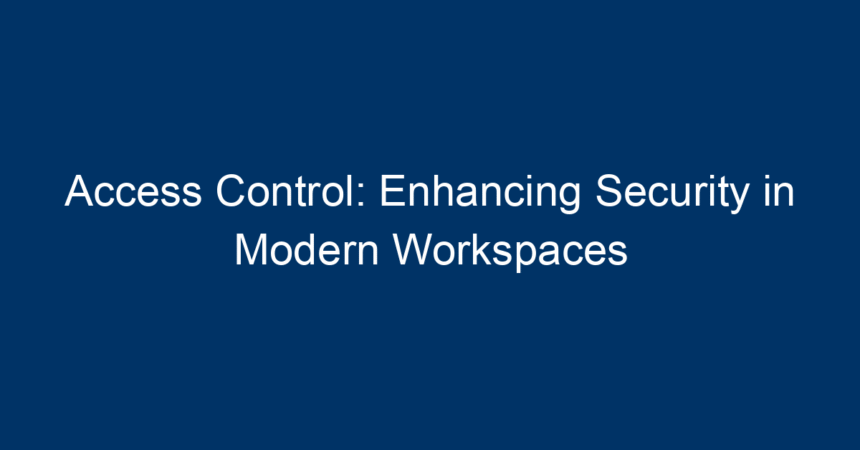In today’s fast-paced world, businesses are continuously looking for ways to enhance security in their workplaces. One of the most effective strategies has been the implementation of access control systems. As organizations evolve to accommodate hybrid work environments—combining remote and in-office work—the need for robust security measures has never been more crucial. This article explores how access control can bolster security, improve operational efficiency, and foster a safe work atmosphere.
What is Access Control?
Access control is a cybersecurity practice that regulates who can view or use resources in a computing environment. It involves a series of mechanisms that restrict access to physical or digital assets based on user identities and permissions. Effective access control protects sensitive information, reduces the risk of breaches, and ensures compliance with industry regulations.
Types of Access Control
Access control systems can be categorized into three primary types:
-
Physical Access Control
- Controls access to physical spaces like buildings, offices, and server rooms.
- Common measures include ID card systems, biometric scanners, and security guards.
-
Logical Access Control
- Manages access to digital resources such as databases, applications, and networks.
- Includes measures like passwords, encryption, and user authentication.
- Administrative Access Control
- Encompasses policies and procedures that govern access management.
- Involves employee training, compliance checks, and continual monitoring.
Each type of access control serves a different purpose but collectively enhances security in modern workspaces.
The Importance of Access Control in Workspaces
Protecting Sensitive Information
In a world where data breaches can lead to significant financial losses and reputational damage, protecting sensitive information is paramount. Access control restricts unauthorized users from accessing confidential data, thereby reducing the risk of data theft. By implementing tiered access levels, organizations can ensure that employees only have access to information relevant to their roles.
Enhancing Compliance and Regulations
Organizations must comply with various regulations like GDPR, HIPAA, and PCI-DSS, which dictate how sensitive information should be safeguarded. Access control is a key component in achieving compliance. It provides an audit trail that can be reviewed to ensure adherence to these regulations, thereby avoiding costly penalties.
Reducing Security Risks
With the rise of remote work, businesses face unique challenges in securing their digital infrastructure. Poorly implemented access control can expose organizations to phishing attacks and insider threats. By establishing strict access protocols, businesses can mitigate these risks and create a layered security approach.
Improving Operational Efficiency
Access control systems streamline workflow by allowing employees to access the resources they need without delays. Automated systems can manage entry and exit efficiently, contributing to a more organized and productive work environment.
Implementing Access Control in Modern Workspaces
1. Assess Your Security Needs
Before implementing an access control system, conduct a thorough assessment of your organization’s security needs. Identify sensitive areas, critical data, and the specific roles that require different access levels.
2. Choose the Right Technology
Selecting the right technology for access control is crucial. Consider options such as:
- Keycard Systems: Cost-effective and easy to manage.
- Biometric Scanners: Provide a higher level of security but can be more expensive.
- Mobile Access: Allow users to access facilities using smartphones, integrating seamlessly with app-based security solutions.
3. Establish Clear Policies
Develop comprehensive access control policies that outline how access levels are assigned, maintained, and revoked. Ensure that employees are aware of these policies and trained to follow them.
4. Regularly Review and Update
Regularly audit your access control systems to identify any vulnerabilities. Update access levels as employee roles change, and always revoke access for employees who leave the organization.
5. Monitor and Respond
Implement continuous monitoring systems to detect any unauthorized access attempts. Utilize analytics to track usage patterns and respond proactively to potential security threats.
Best Practices for Access Control
-
Use Multi-Factor Authentication (MFA)
- MFA adds an extra layer of security by requiring users to provide multiple forms of verification before accessing critical systems.
-
Least Privilege Principle
- Grant users only the access they need to perform their jobs. This limits the potential for data breaches.
-
Employee Training
- Regularly train employees on access control policies to ensure they understand the importance of maintaining security protocols.
-
Emergency Protocols
- Develop and communicate emergency access procedures for critical situations that may require temporary access overrides.
- Invest in Access Control Analytics
- Use analytics tools to track access patterns and identify anomalies in behavior, which may indicate a security breach.
The Future of Access Control in Workspaces
As technology continues to evolve, so must access control systems. Innovations in artificial intelligence, machine learning, and cloud computing are paving the way for more sophisticated and integrated access control solutions. With the growing trend of remote work, future access control systems will likely emphasize seamless and secure remote access protocols.
Integration with IoT Devices
With the increasing adoption of Internet of Things (IoT) devices in workplaces, integrating these into access control systems will offer an enhanced layer of security. IoT devices can provide real-time data on access patterns, further tightening security measures.
Remote Access Solutions
The future of access control will not only focus on physical premises but also on ensuring secure remote access to organizations’ digital resources. Solutions that allow secure connections to corporate networks will enhance flexibility without compromising security.
Conclusion: Actionable Insights for Strengthening Access Control
In conclusion, access control is a critical component in enhancing security within modern workspaces. By implementing the right access control systems and practices, businesses can significantly reduce risks while improving operational efficiency. Organizations must continuously assess their security needs, choose the right technology, and keep abreast of emerging trends and best practices to effectively safeguard their resources.
Start today by reviewing your current access control measures and identifying areas for improvement. Prioritize employee training and establish compliance protocols that enhance your security posture. By fostering a culture of security awareness, you can create a safer and more efficient workspace for everyone.




